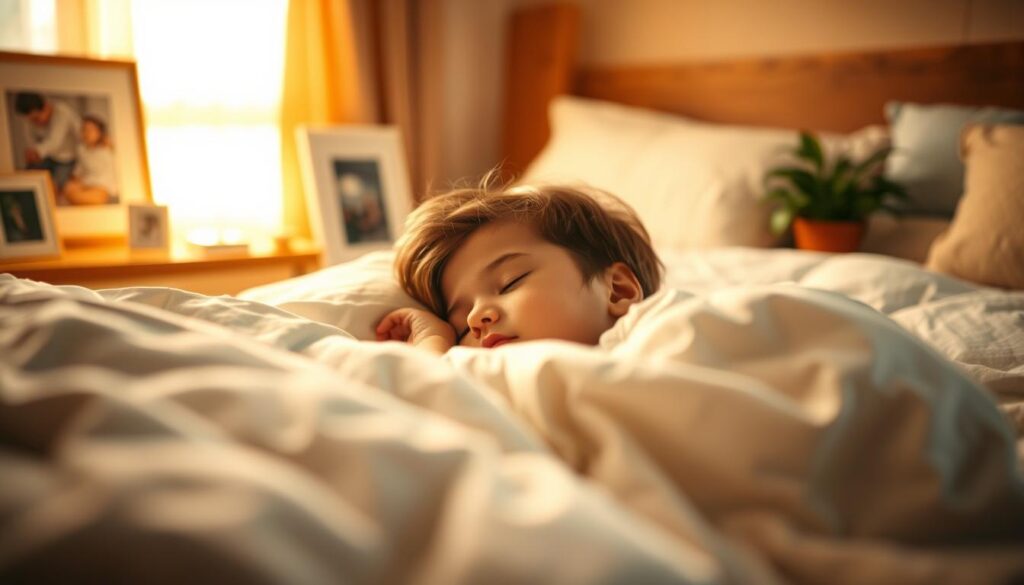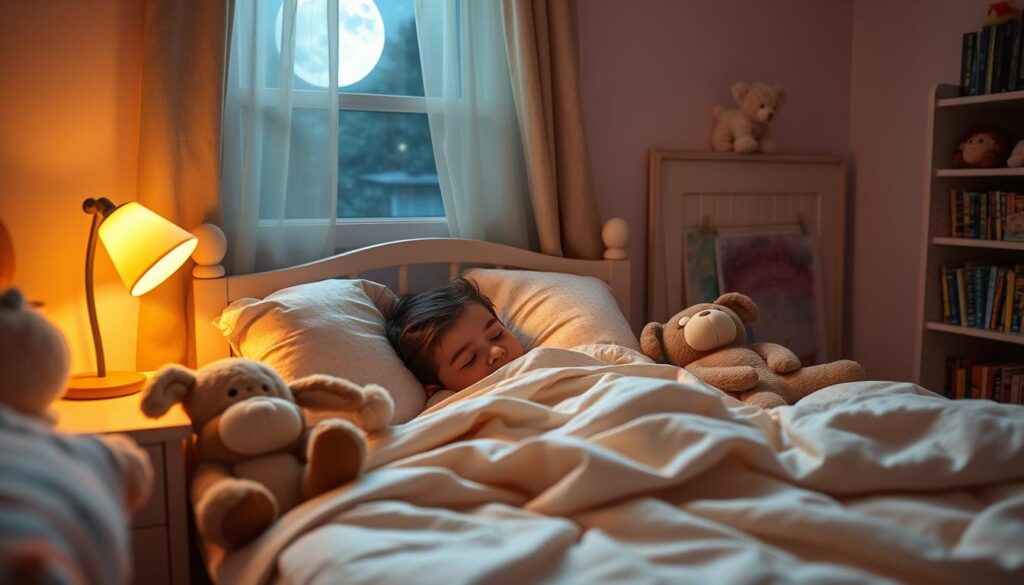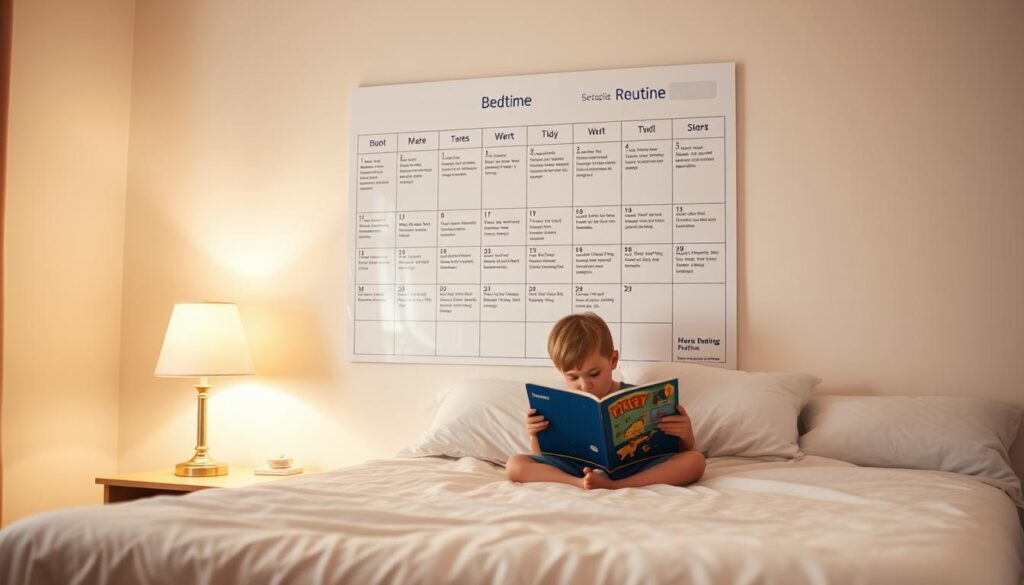Bedtime Routine Ideas for Kids
When Sarah noticed her 6-year-old tossing through storytime every night, she realized their evenings needed structure. Like 33% of Americans (CDC data), her family struggled with inconsistent rest – until they discovered the power of predictable nightly habits. Sleep specialists confirm what Sarah learned: regular evening patterns boost brain development and long-term wellness in children.
This guide shares science-backed methods to help families wind down effectively. You’ll find adaptable approaches for different ages – whether you’re soothing a toddler or negotiating with a screen-loving tween. Consistent schedules don’t just prevent meltdowns; they build lifelong skills for managing stress and energy.
Quality rest impacts more than morning moods. Research shows proper sleep cycles support memory formation, immune function, and even growth spurts. By establishing healthy patterns now, you’re giving kids tools to thrive academically, socially, and physically.
Key Takeaways
- Early sleep habits influence lifelong health outcomes
- Evening consistency reduces nighttime resistance
- Tailored approaches work best across age groups
- Proper rest enhances learning and emotional balance
- Pre-bedtime activities impact sleep quality
Understanding the Importance of a Bedtime Routine for Kids

Parents often underestimate how nightly habits shape their child’s future health. Calming evening activities do more than ease transitions to sleep—they lay foundations for physical and mental well-being. Regular patterns help bodies release growth hormones and minds process daily experiences, creating a ripple effect that lasts decades.
Building Blocks for Growing Bodies and Minds
During deep sleep, children’s bodies repair cells and strengthen immunity. This nightly maintenance supports everything from bone development to fighting off germs. One study found kids with quality rest have 40% fewer sick days than peers with irregular sleep schedules.
Mental benefits shine just as brightly. Sleep fuels memory consolidation—the process where brains turn daily lessons into long-term knowledge. Children with good sleep habits often show better problem-solving skills and emotional control during challenging tasks.
Consistent evening patterns also lower stress hormones like cortisol. This natural relaxation response helps kids wake up refreshed, ready to engage with friends and schoolwork. Over time, these habits reduce risks for serious health issues, including obesity and heart concerns later in life.
By prioritizing sleep health today, you’re giving children tools to thrive tomorrow. Simple choices—like reading together or dimming lights—create lasting impacts far beyond nighttime comfort.
Setting Up a Consistent Pre-Sleep Schedule

Jamie’s nightly battles over screen time ended when her family introduced structured wind-down periods. Aligning evening activities with natural energy dips helps children transition smoothly toward rest. Predictable schedules act like invisible scaffolding, supporting healthy sleep patterns without constant negotiations.
Finding Your Family’s Sweet Spot
Start by counting backward from morning alarms. If your third grader needs 10 hours of nightly rest and wakes at 7 AM, lights-out should hit by 9 PM. Sleep specialists emphasize keeping this timing steady across weekends—variations beyond 45 minutes disrupt circadian rhythms.
Build buffer zones before target sleep hours. Younger children often need 90-minute windows for pajamas, stories, and calming activities. Teens might manage with 60 minutes, but require clear cutoffs for devices emitting sleep-disrupting blue light.
Crafting Your Nightly Game Plan
Visual timetables work wonders for resistant sleepers. Try color-coded charts showing when snacks end, baths start, and reading begins. Gradually shift these markers during schedule changes—15-minute daily adjustments prevent meltdowns when school terms begin.
Consistency thrives on simple rules. Maybe tablets lock at 7:30 PM, or living room lights dim at 8:15 PM. These cues help bodies recognize approaching rest without constant reminders. Over time, kids internalize the sequence, making evenings calmer for everyone.
Calming Techniques to Ease the Transition to Sleep

When 8-year-old Mia started dreading nights due to racing thoughts, her parents discovered a game-changer: body-mind relaxation strategies. These methods help children shift from daytime energy to nighttime calm through intentional physical and mental exercises.
Using Progressive Muscle Relaxation Methods
Progressive muscle relaxation teaches kids to recognize tension. Start by having them squeeze toes for 5 seconds, then release. Move upward through legs, tummy, and shoulders. “This practice helps bodies understand what true relaxation feels like,” explains pediatric sleep consultant Dr. Emily Torres.
Children often giggle during face-scrunching exercises, turning anxiety into play. Over time, this technique builds awareness of stress signals while creating a physical reset button before sleep.
Incorporating Mindful Breathing and Meditation
Four-square breathing works wonders: inhale for 4 counts, hold for 4, exhale for 4. Pair it with visualization – imagine blowing up a balloon or floating on clouds. These exercises activate the body’s natural relaxation response.
Guided meditation apps made for kids use stories about magical forests or space adventures. This approach helps minds release worries without direct confrontation. Regular practice strengthens emotional regulation skills that extend beyond nighttime.
Parents report calmer mornings when children use these tools consistently. As one mother shared: “Now when my daughter feels restless, she starts her ‘relaxation mission’ without prompting.”
Creating a Sleep-Friendly Environment
Many parents overlook how their child’s surroundings directly shape rest quality. A well-designed bedroom environment acts like a lullaby for the senses, signaling it’s time to power down. Let’s explore how to craft spaces that invite deep, restorative slumber.
Optimizing Your Child’s Bedroom for Better Sleep
Start with temperature control. Research shows 65-68°F (15-19°C) helps bodies cool naturally for sleep onset. Pair this with blackout curtains that block streetlights and early sunrises.
| Sleep Factor | Ideal Setting | Common Mistake |
|---|---|---|
| Temperature | 65-68°F | Heavy blankets |
| Lighting | Complete darkness | Night lights |
| Noise | White noise at 50 dB | Total silence |
Choose breathable cotton sheets and firm mattresses that support growing spines. A clutter-free space with soft blue or green walls can lower heart rates by 8% before rest, according to color psychology studies.
Managing Screen Time and Evening Lighting
Devices are sleep thieves in disguise. The blue light from screens delays melatonin production by 90 minutes – like perpetual sunset confusion for brains. Establish a “tech curfew” 90 minutes before bed.
| Device | Cutoff Time | Alternative |
|---|---|---|
| Phone | 7:30 PM | Audio books |
| Tablet | 7:00 PM | Puzzle games |
| TV | 6:45 PM | Family chat |
Install red-light filters on phones two hours before bed. Charge devices outside the bedroom to resist midnight scrolling temptations. These changes help transform the bed into a true sanctuary for nightly renewal.
Incorporating Relaxing Rituals and Warm Bath Ideas

Transform evening struggles into peaceful moments by harnessing water’s natural calming power. Evening rituals that engage multiple senses can become powerful sleep signals for young minds and bodies.
Why Temperature Matters
Science reveals a clever trick: taking warm baths triggers your child’s internal cooling system. As water evaporates, it mimics the body’s natural temperature drop before sleep. This process boosts melatonin production by up to 25%, according to sleep researchers.
Time baths 60-90 minutes before lights-out for maximum effect. Try adding 2-3 drops of lavender oil to warm water – the scent activates relaxation receptors in the brain. For older kids, let them choose bath bombs or shower steamers to build excitement.
Create multi-sensory experiences:
- Use dimmable waterproof lights
- Play nature sounds at low volume
- Offer soft washcloths for face cooling
Teens might prefer warm showers with eucalyptus spray. Pair water rituals with quiet chats about the day’s highlights. These moments help minds unwind while bodies prepare for deep, restorative sleep.
Remember: Consistency turns splashes into sleep signals. Over time, the simple act of taking warm baths becomes a cherished bridge between busy days and peaceful nights.
Enhancing Sleep Hygiene for Better Night Sleep

Did you know the right snack could be your secret weapon for smoother nights? Sleep hygiene isn’t just about darkness and quiet—it’s a whole-system approach combining smart nutrition and daytime habits. Let’s explore how small tweaks to your family’s daily patterns can create big improvements in rest quality.
Healthy Pre-Bed Snacks and Nutrition Tips
Timing matters more than you think. Offer light snacks 60-90 minutes before bed—close enough to curb hunger, but early enough for digestion. Try these sleep-friendly options:
- Cherries (natural melatonin source)
- Bananas with almond butter (magnesium boost)
- Whole-grain crackers (complex carbs for steady energy)
Avoid sugary treats that cause energy spikes. Warm chamomile tea with honey makes a soothing alternative to water. “Foods rich in tryptophan help produce sleep-inducing serotonin,” notes pediatric nutritionist Dr. Lisa Yang.
Managing Daily Habits to Support Nighttime Rest
Daylight exposure before noon helps reset circadian rhythms. Aim for 30 minutes of morning sunshine—it boosts vitamin D and signals “wake-up time” to young bodies. After-school activities should wind down by 6 PM to prevent overstimulation.
Create household rules everyone follows:
- No caffeine after 2 PM
- Dinner served 3 hours before bed
- Quiet hours starting 60 minutes before sleep
These shared practices make sleep hygiene a family priority rather than a child-specific chore. Track progress with a simple chart—note bedtimes, wake-up moods, and snack choices to spot patterns.
Building a Comprehensive Bedtime Routine

The Johnson family transformed nightly chaos into calm by mapping their evening like a board game—each space representing a step toward rest. Effective sequences blend consistency with personal touches, creating rhythms that children naturally follow.
Blueprint for Peaceful Evenings
Start with a 45-minute window before target sleep. Sample timeline:
- 6:45 PM: Bath with lavender bubbles
- 7:10 PM: Brush teeth & pajamas
- 7:20 PM: Shared reading time
- 7:35 PM: Gratitude sharing & lights out
This progression helps young brains shift gears. “The key is maintaining activity order, not exact times,” advises sleep coach Marissa Klein. Adjust durations based on age—toddlers might need 60 minutes, while tweens thrive with 30-minute sequences.
Tailoring Your Family’s Formula
Identify non-negotiable elements that signal sleep preparation. For some families, it’s toothbrushing followed by three stories. Others use soft music during pajama time. Let older children choose between two approved activities to maintain structure while offering autonomy.
Consider developmental needs:
- Preschoolers: Include stuffed animal “goodnight” rituals
- Elementary kids: Add worry-journaling time
- Teens: Permit audiobook listening until lights-out
These personalized touches make the pattern feel special rather than restrictive. As one parent noted: “Our dinosaur-themed ‘pre-sleep quest’ turned dread into excitement.”
Adapting the Routine as Your Child Grows
As children reach new developmental stages, their evening needs evolve dramatically. What worked during diaper years often falls flat with backpack-toting kids. Flexible frameworks maintain calm transitions while respecting growing independence.
Tips for Toddlers and Preschoolers
Keep activities short and sensory-focused. A 15-minute sequence with bath time, toothbrushing songs, and board books works best. Use picture charts showing pajama dinosaurs “marching to bed” – visual cues help little ones grasp sequences.
Stick to concrete timers like sand clocks or color-changing nightlights. “Predictability is security at this age,” notes child therapist Amy Reynolds. Avoid overcomplicating – three consistent steps create lasting patterns.
Suggestions for School-Age Children
Involve kids in designing their wind-down process. Let them choose between journaling or stretching exercises after homework. Gradually introduce responsibility: pre-teenagers can set phone alarms for device shut-off times.
Address school-related stress with worry jars – write concerns on paper to “lock away” overnight. Shift focus to preparation: laying out clothes or packing lunches signals tomorrow’s readiness. These adjustments honor growing autonomy while preserving restorative rest.
Regularly revisit your family’s approach. What soothed a 4-year-old might irritate a 9-year-old. By staying attuned to changing needs, you’ll build lifelong sleep skills that flex with life’s phases.
FAQ
How does a consistent pre-sleep schedule improve my child’s rest?
Can progressive muscle relaxation help kids unwind?
Why is screen time management important before bed?
What makes a warm bath beneficial for sleep?
How does nutrition affect nighttime rest?
Should the routine change as my child grows older?
What if my child resists the routine?
How can I optimize their bedroom environment?

Adam Peter is a finance, travel, and automotive writer with over a decade of experience. He creates clear, practical content to help readers manage their money, explore the world with confidence, and make informed decisions about cars and travel gear. His work blends expert insight with real-world usefulness.




